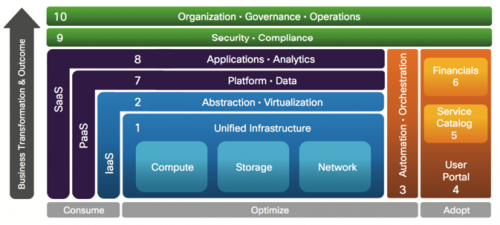
Data centres are complicated things, right? Little wonder with so many buzzwords used as adjectives and the rapid pace of technology change driven by the many vendors. Not to mention overly complicated designs that are complex to run and manage.
Look at how data centres have evolved over the past 10 years. From the point of buying a server and running a single application on it, to the situation today:
- Applications that are ever changing and cloud-native
- Spanning multiple virtual servers across multiple locations and traversing many networks
This scenario doesn’t lend itself to simplicity.
Meanwhile, data centres have grown into bolt-on, multivendor and non-architectural solutions that struggle to address current needs, let alone future trends.
It’s suffice to say data centres need to become a whole lot simpler.
Stages of evolution
Looking at the current IoT trend of connecting more and more things to the internet and writing supporting apps that try to rationalise information coming to us from these connections. Data centres need evolve to be able to provide agility by using design components that:
- Scale quickly and support automation
- Are open and complementary, systems performant and always on
Such features bring immediate business value from what otherwise can seem like a never ending investment for CFOs.
Everyone I speak with is at different stages in the evolution of their data centre. Some have standardised; others haven’t. Some have many different teams looking to work together to configure and manage; others have a flat structure.
Some are using automation tools; others are manually programming. Some are moving workloads to public data centres; others are opposed to letting anything leave the corporate boundaries.
All, however, tell me the same thing: that end goals are to simplify, improve availability, reduce costs and drive business value. But all have different ideas about how to get there.
So it seems the desire is concurrent but the methods are not. If we keep going the way we are, more confusion, complexities and costs are coming.
So what if I told you it doesn’t have to be this way?
Recipe for success
There is such a thing as a formula for removing confusion in the data centre. To explain this, I’m going to digress to cooking, which is a huge passion of mine.
I believe cooking a special meal is similar to designing a data centre. I am no Michelin Starred Chef, but I am a good cook and I often look to my favourite Chefs for guidance and inspiration. After all, they are the experts. I read their recipe, source the best ingredients I can and follow a tried and tested method to deliver a result that brings joy to everyone that eats it (and a sense of satisfaction to me as the cook).
If, however I just buy random ingredients and try to blend them with no help or guidance, the result in all likelihood is a costly disaster, with further expense in buying a takeaway to feed my hungry guests.
So let me now put that chain of thought in the context of a data centre and IT.
Cisco is an IDC MarketScape “Major Player” worldwide for Cloud Professional Services and Data Centre Transformation Consulting and Implementation Services. We’re also a “Worldwide Leader” for Data centre Hardware Support Services.
So we are the experts in our field in the eyes of analysts and buyers. What’s more, we’ve a book of recipes for creating a successful data centre.
Known as ‘Domain Ten’, this vendor agnostic framework comes with a series of workshops to help you plan and execute IT transformation across an end-to-end IT function of infrastructure components, applications, security, operations and automation.
Finest ingredients
The outcome is a 24-36 month step by step roadmap (the recipe) specific to your business needs to achieve IT transformation. Cisco’s products and services (the finest ingredients) are designed to work together and produce measurable benefits like faster time to revenue, lower infrastructure costs, reliable disaster recovery and reduced application deployment times.
As you can see, the Domain Ten framework covers all the elements needed for IT Transformation:

The Domain Ten framework covers the entire IT function. Domains 1-2 cover infrastructure, Domains 3-6 cover user’ needs, Domains 7-8 address future app development and Domains 9-10 address executive level strategy planning.
There’s never been a better time to simplify your data centre design. And there’s no better recipe for success than Cisco and Domain Ten.
Contact your Cisco Account Manager to book a workshop.

